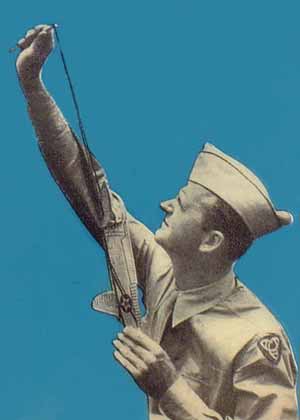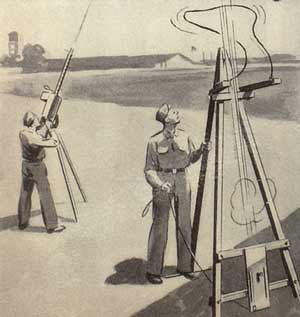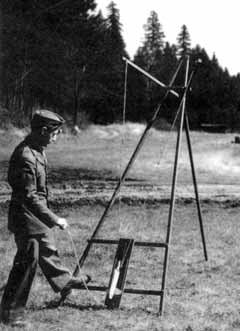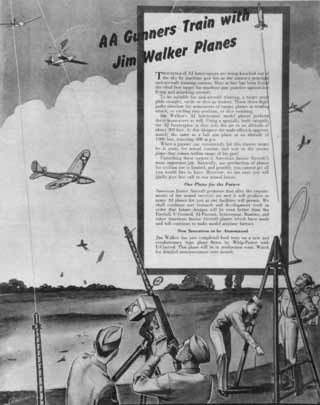When World War II broke out in Europe, Jim Walker began to think of how to use different types of model airplanes to aid in the war effort. At that time he was thinking of large Radio Controlled planes, never dreaming that there was anything in the toy field that would meet army needs.
One day in Texas, a colonel who had bought dozens of the toy gliders for his own children, walked into a variety store and picked up a handful of American Junior Aircraft's little Army Interceptor folding wing gliders. "Heck," he said, "these are the babies we want." Consequently an order for 500 of the planes came from the instructor's training headquarters in Texas. This was followed shortly by an order for 1,000 and then one for 5,000.
They were used at infantry training centers, anti-aircraft training centers, tank destroyer schools, coast guard artillery schools and naval training stations and by the allies. These were unique model planes in that they used a catapult to achieve great heights and glides of up to 30 minutes. The following information explains how the military adapted the Army Interceptor for wartime use.
 |
Launching the old fashioned way, but the U.S. Military had a better way to get the Interceptor high into the air. |
The model aviation industry had a difficult time during World War II because there was a shortage of building supplies. Most model companies had to scale back on production, the one exception was American Junior Aircraft. The military saw potential in the folding wing model called the Army Interceptor an adopted it as a target ptactice plane for aerial gunners.
A special Military Launcher was designed to catapult the Interceptor high into the air. The Interceptor reached an altitude of 300 feet before deploying it's wings and going into glide mode. The effect of this altitude and speed of glide simulated a real plane and provided a great moving target for the ground based gunners. The dropping of the name "Army" was discussed and laughed about, as the "Navy and Marines loved shooting the Army out of the air"
but thats as far as it went. "Army" was done away with the introduction of the "404" in 1947.
We offer a little history of this "war bird" and the Military Catapult Launcher. Then from 1943 we zoom ahead 60 years to see the 2004 Military Launcher in action again through the efforts of Frank Macy and American Junior Classics. Here, for the first time, you will see how the launcher worked and the Army Interceptor riding high into the currents of air once again.
American Junior Aircraft Company was one of the few model airplane companies to acually show growth during this time of shortages. Because of the Interceptor's role in the war effort A-J Aircraft had access to the crutial war material known as balsa.
 PLANES by the thousands are being knocked out of American skies by antiaircraft gunners in training at Army camps and naval air stations all over the country. They are glider models, shot into the air with folded wings from slings or catapults and used as targets for machine guns as they glide, circle, or dive realistically.
PLANES by the thousands are being knocked out of American skies by antiaircraft gunners in training at Army camps and naval air stations all over the country. They are glider models, shot into the air with folded wings from slings or catapults and used as targets for machine guns as they glide, circle, or dive realistically.
The model planes used are a product of the American Junior Aircraft Company, of Portland, Oregon. Designed originally for model plane enthusiasts, they lend themselves admirably to target use. With its wings folded back against its fuselage, as seen in the photograph below, one of these balsa-wood "Interceptors" can be hurled to a great height (300 feet when the catapult is used). In the air, rubber bands snap the wings forward into position.
Models can be adjusted to glide straight, circle, or dive as desired, simulating the maneuvers of enemy planes in low-level at-tack. At 300 feet, the scale effect is that of a full-size plane at 1,500 feet, traveling 300 miles an-hour.
 |
Military Launcher with Interceptor loaded at Fort Lewis, WA in 1943. |
AA Gunners Train with Jim Walker Planes
THOUSANDS of A-J Interceptors are being knocked out of the sky by machine gun fire at the nation's principal anti-aircraft training centers. Here at last has been found the ideal free target for machine gun practice against low flying and attacking aircraft.
To be suitable for anti-airciraft training, a target must glide straight, circle or dive as desired. These three flight paths simulate the maneuvers of enemy planes in strafing attack, or circling into position, or dive bombing.
Jim Walker's A-J Interceptor model planes perform these maneuvers at will. Using a specially built catapult, the A-J Interceptor is shot into the air to an altitude of about 300 feet.
 When a gunner can consistently hit this elusive target he is ready for actual combat, and woe to the enemy plane that comes within range of his gun!
When a gunner can consistently hit this elusive target he is ready for actual combat, and woe to the enemy plane that comes within range of his gun!
Furnishing these targets is American Junior Aircraft's most important job. Naturally, our production of planes for civilian use is limited, and possibly you cannot get all you would like to have. However, we are sure you will gladly give first call to our armed forces.
Our Plans for the Future:
American Junior Aircraft promises that after the requirements of the armed services are met it will produce as many A-J planes for you as our facilities will permit. We shall continue our research and development work in order that future designs will be even better than the Fireball, U-Control, A-J Pursuit, Interceptor, Bomber, and other American Junior Aircraft planes which have made and will continue to make model airplane history.
New Sensation to be Announced:
Jim Walker has just completed final tests on a new and revolutionary type plane flown by Whip-Power with U-Control. This plane will be in production soon. (Published in April, 1943)
 |
Another photograph from Fort Lewis, Washington in 1943. Here you can see two Interceptors in the air far in the distance. |
Sixty years after these photos were shot, Frank Macy
built a replica of the Military Launcher. On July 19, 2004 he tested it at
McMinnville, Oregon. In the short movie we made, is his assistant Sarah Lander.
Video
was shot by Scott Griffith, A-J Classics media man.
 Click here to watch Frank Macy's 2004 Military Launcher in Action
Click here to watch Frank Macy's 2004 Military Launcher in Action 
Home | Jim Walker | FireWire | Air Mail | Workshop | Short Takes | Fireball | Firebaby | A-J Store
